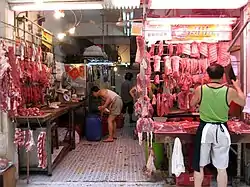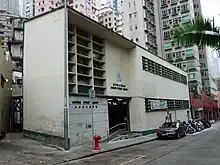| Wet market | |||||||||||
|---|---|---|---|---|---|---|---|---|---|---|---|
 A meat stall at a wet market in Hong Kong | |||||||||||
| Traditional Chinese | 傳統市場 | ||||||||||
| Simplified Chinese | 传统市场 | ||||||||||
| Hanyu Pinyin | chuántǒng shìchǎng | ||||||||||
| Jyutping | cyun4 tung2 si5 coeng4 | ||||||||||
| Literal meaning | traditional market | ||||||||||
| |||||||||||
| Alternative Chinese name | |||||||||||
| Traditional Chinese | 街市 | ||||||||||
| Simplified Chinese | 街市 | ||||||||||
| Jyutping | gaai1 si5 | ||||||||||
| Literal meaning | street market | ||||||||||
| |||||||||||
In Hong Kong, wet markets are traditional markets that sell fresh meat, produce, and other perishable goods. There are wet markets in most neighbourhoods of Hong Kong and they often cater to older residents, low-income residents, and domestic workers. They are regulated by the Food and Environmental Hygiene Department (FEHD).
Early history

On 16 May 1842, Central Market was opened in a central position on Queen's Road in Hong Kong. In this market, people could find all kinds of meat, fruit and vegetables, poultry, salt fish, fresh fish, weighing rooms and money changers.[1]
In 1920, the Reclamation Street Market was opened in Hong Kong. Due to structural problems, Reclamation Street Market was removed by the government in 1953.[2] In 1957, Yau Ma Tei Street Market launched to replace the Reclamation Street Market.[3] There were fixed-pitch stalls which sold vegetables, fruits, seafood, beef, pork, and poultry. Also, there were stalls selling baby chickens, baby ducks, and three-striped box turtles as pets.[4]
Popularity

In 1994, wet markets accounted for 70% of produce sales and 50% of meat sales in Hong Kong.[5]
In Hong Kong, wet markets are most frequented by older residents, those with lower incomes, and domestic helpers who serve approximately 10 percent of Hong Kong's residents.[6] Most neighbourhoods contain at least one wet market.[7] Wet markets have become destinations for tourists to "see the real Hong Kong".[8]
Ownership
In 2018, the FEHD operated 74 wet markets housing approximately 13,070 stalls.[9] In addition, the Hong Kong Housing Authority operated 21 markets while private developers operated about 99 (in 2017).[10] As of 2018, planning is underway for new wet markets in the new towns at Tung Chung, Tin Shui Wai, Hung Shui Kiu, Tseung Kwan O, and Kwu Tung North.[9] Since many of the wet market buildings are owned by private property investment firms, the prices of food can vary from market to market.[11]
Practices
Hong Kong's wet markets are known to use red lampshades to make the food look fresher.[12]
Inhumane slaughter methods are often used, including air asphyxiation of large numbers of live fish. According to a Dutch study, it takes 55-250 minutes for various species of fish to become insensible during this process.[13]
Regulations
_Market.jpg.webp)
Prior to 2000, many of Hong Kong's wet markets were managed by the Urban Council (within Hong Kong Island and Kowloon) or the Regional Council (in the New Territories). Since the disbandment of the two councils on 31 December 1999, these markets have been managed by the Food and Environmental Hygiene Department (FEHD) of the Hong Kong government.[9][14]
Markets in Hong Kong are governed by the law of Hong Kong. Under the Slaughterhouse Regulation, the slaughtering of live bovine animals, swine, goats, sheep or soliped for human consumption must take place in a licensed slaughterhouse,[15] None of the wet markets in Hong Kong hold wild or exotic animals.[7]
Poultry
The retail sale of live poultry in Hong Kong is permitted at licensed outlets only.[16] At the end of 2016, there were 85 retail shops within public wet markets licensed to sell live poultry.[16]
In 2008, the government of Hong Kong proposed that all poultry should be slaughtered at central abattoirs to combat the spread of avian flu.[17] The FEHD has implemented a number of measures to reduce the risk of avian influenza. Regular inspections and cleaning take place, including nightly disinfection of each stall by external contractors. Stall owners selling live poultry are not allowed to keep the animals on the premises overnight; they must be slaughtered before 8:00 pm nightly.[18]
See also
References
- ↑ "The Friend Of China, and Hong Kong Gazette" (PDF). 1842-05-12. Archived (PDF) from the original on 6 March 2019. Retrieved 2019-03-04.
- ↑ Bao Shaolin (2012). 第二屆廿一世紀華人地區歷史教育論文集 [Second Collection of Historical Education Papers on Chinese in the 21st Century] (in Chinese). Zhonghua Book Company (Hong Kong) Limited. p. 332.
- ↑ "油麻地新建街市昨晨開幕後營業" [Yau Ma Tei New Market opened after opening yesterday morning]. Hong Kong Business Daily (in Chinese). 1957-11-02. Archived from the original on 6 March 2019. Retrieved 2019-03-04.
- ↑ "Yau Ma Tei's wet markets in the early post-war period". 2011-03-29. Archived from the original on 6 March 2019. Retrieved 2019-03-04.
- ↑ Agricultural Trade Highlights. Foreign Agricultural Service. 1994. p. 7.
- ↑ "EmeraldInsight". EmeraldInsight.com. Archived from the original on 2 May 2014. Retrieved 2016-08-01.
- 1 2 Westcott, Ben; Wang, Serenitie (15 April 2020). "China's wet markets are not what some people think they are". CNN. Archived from the original on 15 April 2020. Retrieved 15 April 2020.
- ↑ Chong, Sei (18 March 2011). "A Guide to Hong Kong's Wet Markets". The New York Times. Archived from the original on 21 January 2012. Retrieved 2016-08-01.
- 1 2 3 "Chapter IV – Environmental Hygiene". Annual Report 2018. Food and Environmental Hygiene Department. Archived from the original on 7 April 2020. Retrieved 7 April 2020.
- ↑ "Public markets" (PDF). Legislative Council Secretariat. 27 September 2017. Archived (PDF) from the original on 30 October 2019. Retrieved 7 April 2020.
- ↑ Elmer W. Cagape (2011-09-08). "Tung Chung town pays the most for food in Hong Kong". Asian Correspondent. Archived from the original on 2 May 2014. Retrieved 2016-08-01.
- ↑ 超巨街市燈現身商場 [Super large wet market red lamps appears in shopping mall]. Sharp Daily (in Chinese). 14 September 2012. Archived from the original on 8 November 2012. Retrieved 19 November 2012.
- ↑ "humane slaughter". fishcount.org.uk. Retrieved 29 May 2021.
- ↑ "Report No. 51 of the Director of Audit — Chapter 6" (PDF). Audit Commission. November 2008. Archived (PDF) from the original on 30 December 2015. Retrieved 7 April 2020.
- ↑ "Cap. 132BU Slaughterhouses Regulation". Hong Kong e-Legislation. Department of Justice.
- 1 2 "Study on the Way Forward of Live Poultry Trade in Hong Kong" (PDF). Food and Health Bureau. March 2017. Archived (PDF) from the original on 9 May 2020. Retrieved 7 April 2020.
- ↑ "Central abattoir set for 2011". Archive.news.gov.hk. 2008-06-13. Archived from the original on 5 March 2016. Retrieved 2016-08-01.
- ↑ "Faecal droppings of live poultry from Yan Oi Market in Tuen Mun tested positive of H7N9 virus". Hong Kong Government. 5 June 2016. Archived from the original on 1 September 2019. Retrieved 7 April 2020.